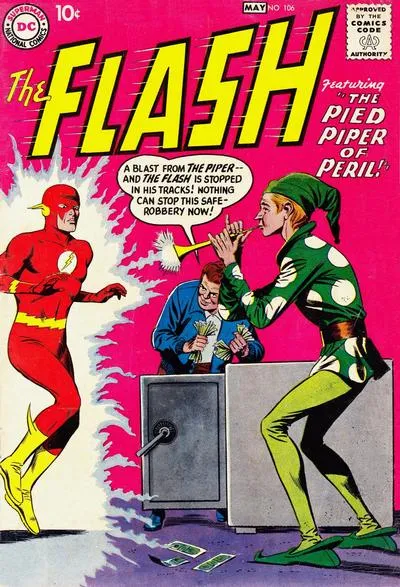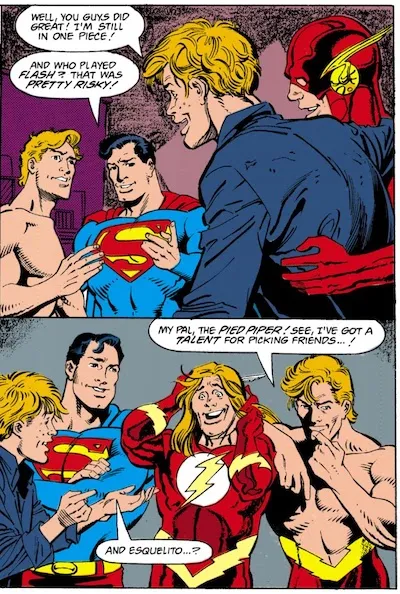
Queer Superhero History: Pied Piper
In recent years, mainstream comics publishers like DC and Marvel have made great strides in increasing the LGBTQ+ rep in their universes, though they still have a long way to go. But getting here was a slow and gradual process, with many notable landmarks — and some admitted missteps — along the way. In Queer Superhero History, we’ll look at queer characters in mainstream superhero comics, in (roughly) chronological order, to see how the landscape of LGBTQ+ rep in the genre has changed over time. Today: Pied Piper!
The characters we’ve covered previously in this series — Extraño, Cloud, and Maggie Sawyer — hid behind a (very, very thin) smokescreen of plausible deniability. They are canonically queer, but certain words are never said, only heavily hinted at. The Pied Piper is the first costumed character in superhero comics to use the word “gay” in relation to himself. Minor civilian characters had used it before, but never someone from the capes and tights set. He’s also the first canonically queer supervillain (albeit a reformed one), and the first character to come out decades after his introduction, as opposed to being introduced as queer from the get-go.

Piper — real name Hartley Rathaway — dates all the way back to the Silver Age. He debuted in The Flash #106 (May 1959), by John Broome and Carmine Infantino (fun fact: this issue also introduced Gorilla Grodd!). Initially he was a typical Flash villain: a bank robber with a gimmick. In his case, he committed crimes via highly implausible uses of sound waves as “the master of sound.”
Though his first appearance gives no backstory for him, we would eventually learn that he was born deaf, but that his wealthy parents paid for groundbreaking assistive technology that made him able to hear and left him obsessed with sound and its potential. He turned to crime mostly because he was bored, since he didn’t need the money.
Piper spent the next few decades as a fairly generic member of the Flash’s Rogues Gallery, but in the late 1980s, after the Silver Age Flash (Barry Allen) had died and his nephew Wally had taken over, Piper reformed and became an ally of the Flash instead of an enemy, as well as a progressive firebrand deeply invested in issues of social justice. And in The Flash #53 (August 1991), by William Messner-Loebs and Greg LaRocque, he came out.
The issue opens with Wally and Piper hanging out on a roof and chatting about the Joker, who Piper knew slightly in his villain days. Wally asks if the rumors are true: is the Joker gay? “Guys like that, you can always tell…there are signals,” Wally says confidently.
Piper says he doesn’t think the Joker is gay. In fact, he can’t think of any supervillains who are…except himself.

Shocked, Wally babbles that of course he knew that and of course it doesn’t bother him and oh no look at the time, gotta run! As he speeds away, he thinks with relief that at least he was “slick enough” that Piper didn’t notice his profound discomfort, which…oh, buddy, no you weren’t.
Later, Wally teams up with guest star Superman to rescue Jimmy Olsen from a metahuman kidnapper. Wally’s plan involves a bait and switch, with Wally in disguise and someone else wearing the Flash costume. The last page reveals that someone else to be Piper. “See, I’ve got a talent for picking friends!” Wally says, leaning affectionately on Piper, and thus answering the unspoken question from the beginning of the issue: despite Wally’s initial shock and discomfort, their friendship remains unchanged.

Obviously in an ideal world, it wouldn’t have taken Wally an entire issue to reach that conclusion, and certainly the way he talks about gay men in the opening pages is…not enlightened. But fumbling his way through character growth was very much Wally’s M.O. during this era, and Piper’s cheerful, matter-of-fact coming out is a far cry from the careful (and often self-loathing) language used by characters like Extraño and Maggie Sawyer just a few short years prior.
Piper would usher in a generally more matter-of-fact treatment of queer characters over the next few years, with a number of (admittedly always very minor) characters casually coming out without a whiff of angst, and zero gay bashing — again, a far cry from the ’80s. That’s not to say that everything about how queer characters were depicted had totally changed. Piper’s love life is heavily sanitized — he has a civilian boyfriend named James for a while, who has no personality to speak of, and that’s it.
And of course the topic of AIDS does eventually come up, as it always did for queer male characters at the time — specifically, in The Flash #60, when Wally asks in typical clumsy but well-meaning fashion if Piper’s being careful. Piper wryly but gently points out that he knows a lot more about HIV than Wally does, and that between the two of them, Wally is the one with a reputation for promiscuity and carelessness — at which point Wally quickly changes the subject. But the scene doesn’t read as stereotypical or fear-mongering, and has none of the irresponsible factual inaccuracies of Extraño’s story a few years earlier. Instead, it treats a serious subject with the gravitas it deserves, and reminds its readers that straight people need to be educated and responsible too. Once again, Piper’s story highlights a gradual cultural shift (plus the importance of thoughtful, compassionate writing).

Piper remained a steady supporting member of the Flash cast for about 15 years. Then along came 2007’s Countdown, a 52-issue weekly series that juggled multiple plot threads. In one of those threads, Piper and fellow reformed Rogue the Trickster found themselves handcuffed together and on the run from heroes who incorrectly believed them to be responsible for the death of Flash #4, Bart Allen. As fellow Rioter Eileen has pointed out, this had all the earmarks of a delightful romcom but was, in fact, hot garbage. Trickster spends the series being relentlessly homophobic to Piper; then both of them die. Piper goes out with a bang, playing a combination of the cosmically destructive Anti-Life Equation with Queen’s “The Show Must Go On,” but a hat tip to Freddie Mercury doesn’t A) improve the series overall, B) erase all the homophobia the reader had to wade through to get to this point, or C) make Piper not dead at the end, so.

When DC rebooted their entire history in 2011 with the New 52, Piper returned as a villain-turned-vigilante, now in a relationship with Barry Allen’s boss, Captain David Singh — a relationship strained by both their differing views on the law (Singh does not approve of vigilantes) and the fact that Singh is in the closet and Piper is not. It’s nice to see Piper in a relationship with a three dimensional character instead of a placeholder…but it’s also a bit jarring for Hartley “ACAB” Rathaway to be dating a cop. It also demotes him from the Flash’s best friend to…the Flash’s boss’s boyfriend, which may be why he had so few appearances in the New 52 era.
Piper showed up even less in the Rebirth era (2016–2020), but he’s recently made his triumphant return to comics — and luckily for him, Wally is once again the lead Flash, which means Piper and Wally were able to pick up their old friendship where they left off. I’m not ashamed to admit I yelled “Piper!” out loud in my empty apartment when he was revealed at the end of The Flash #788 a couple months ago. Because Piper!

I’ve talked about how Piper was in many ways the start of a new, less angsty approach to queer characters, at least at DC, but Piper’s important for another reason I think is often overlooked. As I mentioned at the start, unlike characters like Extraño and Maggie Sawyer, Piper was not intended to be queer when he was created. (Okay, technically I have no proof of this, but I highly doubt any mainstream comic book characters debuting in 1959 were intended to be queer.) Instead, 32 years later, a different creative team decided to depict him as gay.
This may seem like splitting hairs, but superhero comics are all about longevity. It’s vanishingly rare for a brand new character to become anywhere near as popular as a character who is 50, 60, 80 years old. Piper set an important precedent: that just because a character had not been established as canonically queer up to now didn’t mean that they couldn’t be canonically queer going forward. I’m not saying that long-established and beloved characters like Wonder Woman, Iceman, Harley Quinn, Tim Drake, Renee Montoya, and more would never have become canonically queer without Piper — but I’m glad he opened that door a little sooner than it might otherwise have been opened.
Pied Piper is no more an A-list character than any of the others we’ve talked about so far, but he’s been around for 60 years and he’s been out and proud for half of them, and that’s a pretty impressive legacy. I look forward to The Flash every month, since it’s one of the best books DC is publishing right now — and now that Piper is back in the mix, I’ll be looking forward to it even more.
(And hey, DC — maybe revisit the whole Piper/Trickster notion again, huh? For me and Eileen?)











